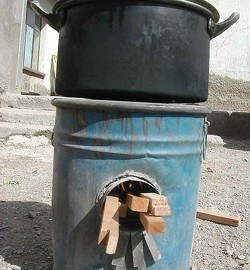Rocket Stove Launches Third World Into Green Orbit

While flipping through a copy of the New Yorker magazine earlier today, I came across an article written by Burkhard Bilger titled “Hearth Surgery”, which took a look at the efforts of a group of scientists and engineers to create an inexpensive and efficient cook stove for use in Third World countries. We’ve all seen the pictures of people in places like Bangladesh or Ethiopia where the masses huddle around cookpots in makeshift dwellings. These are the kinds of images that usually bring to mind the traditional methods the western world uses to provide aid to developing nations — mass vaccinations, massive shipments of grain and water purification equipment.
Luckily for me, the writer had decided to begin his article by describing a scene at Stove Camp in Cottage Grove, Oregon between two of the outsized personalities who inhabit the world of the stovemakers, Dale Andreatta and Peter Scott. Their personal histories and vigorous speech patterns instantly conjured a picture of two modern day Indiana Jones scientist types. But their objective wasn’t to find a spectacular jewel with magical powers. Their task was to re-engineer the cookstove, one of the most basic elements of civilization around the world, in a way that would allow it to be produced cheaply, consume fuel efficiently, and emit smoke sparingly.
With two heroic figures facing a challenge like this, I was hooked.
It wasn’t until I got deeper into the article that I realized just how big a deal their quest was. The article explained that half the world cooks with gas, kerosene, or electricity, and the other half, the half my heroes were concerned about, cooked with wood, coal, dung, or other solid fuels. Which meant that up to three billion plus people could be directly affected by any successes coming out of Stove Camp. It also meant that the other three billion plus people on the planet could see benefits from their work as well – those three billion cook stoves, it turns out, emit an enormous amount of smoke practically every day of the year.
Over the years, the cook stove collective have made progress. In the ten years they’ve been meeting at the Aprovecho Research Center, the loose association between them has fostered a core set of principles about cook stove construction; facilitated the design, manufacture or distribution of two million stoves around the world; and provided the impetus for a first of its kind study to measure the effects of cook stove smoke on the adults and children living in the household. By simply reducing the amount of smoke inside dwellings emitting from cook stoves, they have been able to show a significant decrease in childhood pneumonia, a respiratory disease that fatally strikes an enormous number of Third World children every year.
The Rocket Stove, developed in conjunction with Harry Winiarski, is one of the most prominent markers of the collective’s success. The simple, yet highly efficiency design can literally boil water from the heat generated by burning a bundle of twigs. The potential this cook stove has to dramatically reduce the amount of fuel needed to prepare a meal directly impacts the issue of deforestation, a problem facing many Third World countries.
Hard to believe that all of these things — climate change, childhood mortality, and deforestation — could be affected by one of the most ubiquitous home appliances in the world.





